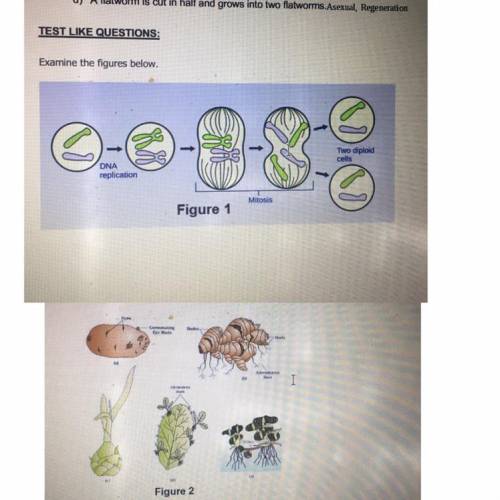
Biology, 19.12.2020 09:50 laurencollett4838
The process modeled in Figure 1 is closely related to the process modeled in Figure 2.
Which of the following BEST explains why the DNA of the daughter cells is the same as the parent?
One cell replicates its DNA and creates new cells after combining genetic material with another
source.
One parent cell replicates its DNA and creates new cells or offspring without a combination of
genetic material from another source.
Two parent cells combine genetic material into one cell, then that cell divides to create new cells or
organisms that are a combination of both parents.
Two parent cells combine genetic material into one cell, then that cell divides to create new cells or
organisms that are identical to only one of the parents.


Answers: 3
Another question on Biology

Biology, 22.06.2019 00:20
1. variations in a population of moths allow for some of its members to be able to adapt to environmental changes. the better adapted of the moths will be able to survive the change and thus prevail as the “fittest” of the species. (a) describe three mechanisms in which variation can occur within a species population. (b) explain which mechanism or mechanisms would be responsible for the survival of a population of peppered moths better than white moths in an environment affected by industrial soot. justify your answer.
Answers: 1

Biology, 22.06.2019 03:30
Students in biology are studying the macromolecules of life. they used a calorimeter to determine the calories in various types of food. once the lab was completed, the students ate the left over food samples. monica commented that in just 6 or 7 "chews" of the saltine, it was gone; nothing but a sticky paste in her mouth. elaborate on what happened chemically while chewing the saltine. include the macromolecules present.
Answers: 1

Biology, 22.06.2019 09:10
Refer to this portion of a dichotomous key for fish identification to answer the question. 1. (a) has a single dorsal fin ® 5 (b) has a double dorsal fin ® 2 2. (a) one fin is spiny, the other is smooth ® 3 (b) one fin is not spiny or smooth ® 4 5. (a) has small fin on back near tail ® 6 (b) has no fin on back near tail ® 7 6. (a) has barbs near the mouth ® catfish (b) does not have barbs near the mouth ® 10 7. (a) tail is asymmetrical ® 8 (b) tail is symmetrical ® 9 10. (a) scales are small ® trout (b) scales are large ® whitefish what is the next step to complete to identify a fish that has a single dorsal fin, no fin on the back near the tail, and no barbs near the mouth? step 2 step 5 step 7 step 10
Answers: 2

You know the right answer?
The process modeled in Figure 1 is closely related to the process modeled in Figure 2.
Which of the...
Questions


Mathematics, 12.12.2020 16:40


Mathematics, 12.12.2020 16:40


Mathematics, 12.12.2020 16:40


Mathematics, 12.12.2020 16:40


Mathematics, 12.12.2020 16:40

History, 12.12.2020 16:40

Mathematics, 12.12.2020 16:40


Social Studies, 12.12.2020 16:40

Mathematics, 12.12.2020 16:40

Mathematics, 12.12.2020 16:40

Mathematics, 12.12.2020 16:40

Computers and Technology, 12.12.2020 16:40


Mathematics, 12.12.2020 16:40



